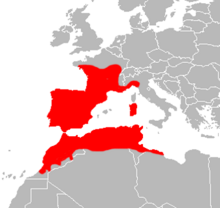Viper snake
| Viper snake | ||||||||||||
|---|---|---|---|---|---|---|---|---|---|---|---|---|

Viper snake ( Natrix maura ) |
||||||||||||
| Systematics | ||||||||||||
|
||||||||||||
| Scientific name | ||||||||||||
| Natrix maura | ||||||||||||
| ( Linnaeus , 1758) |
The Viper snake ( Natrix maura ), and Viper snake , is a non-toxic snake from the family of snakes (Colubridae), which is native to southwest Europe and northwest Africa.
features
The species becomes 70 to 90 (rarely 100) centimeters long, with the males remaining smaller than the females. The rather broad head is clearly separated from the trunk, the back scales are strongly keeled. The somewhat squat body is of a brownish or gray basic color with yellow, red or olive green tint. On the back there are usually two rows of staggered dark spots that can merge into bars or a zigzag strip. This creates a risk of confusion with the adder . In contrast to this, however, the viper snake has, among other things, round pupils. On the flanks there are either simple dark spots or large eye spots with a light center. Sometimes there are also two narrow, light (yellow or reddish) longitudinal stripes on the back. The head is often strongly drawn, for example with one or two V-shaped characters, which can be connected to one another by a central point. Also striking are light-colored upper lip shields ( supralabials ), which are lined with dark.
The closely related dice snake is very similar in appearance and way of life , but its range only overlaps with that of the viper snake in a small area in northwest Italy.
distribution
The distribution area of the viper snake includes the Iberian Peninsula , the Balearic Islands , France (with the exception of Brittany , Normandy , the Channel coast and Alsace ), parts of Switzerland (exclusively in the canton of Geneva and at isolated sites in the canton of Vaud and Valais ), north-west Italy , Sardinia , Corsica and Northwest Africa. The population in Mallorca is due to animals from south-eastern France that were introduced by humans.
Habitat and way of life
The water snake, which is closely tied to aquatic habitats, can often be found in several specimens in the area of sunlit brooks at a suitable location and in favorable weather . There she hunts fish , tadpoles and newt larvae. However, it also hunts adult amphibians , for example the Sardinian mountain newt in Sardinia . The well-swimming and diving snake uses the sunlit banks for thermoregulation . If there are seldom sunbathing spots in the vicinity of the water, she also climbs into the woods of the bank vegetation.
Hazard and protection
Legal protection status (selection)
- Habitats Directive : not listed
- Federal Species Protection Ordinance (BArtSchV): Appendix 1
- Federal Nature Conservation Act (BNatSchG): particularly protected
National Red List classifications (selection)
- Switzerland's Red List : CR (Critically Endangered)
literature
- T. Klesius: The viper snake - Natrix maura. Natur-und-Tier-Verlag, 2009, ISBN 978-3-86659-119-6 .
- Edwin N. Arnold, John A. Burton: Parey's Reptile and Amphibian Guide to Europe. Paul Parey Publishing House, Hamburg / Berlin 1979, ISBN 3-490-00318-7 .
Individual evidence
- ↑ Daniela Guicking, Richard A. Griffiths, Robin D. Moore, Ulrich Joger, Michael Wink: Introduced or alien Persecuted native? Resolving the origin of the viperine snake (Natix maura) on Mallorca. In: Biodiversity and Conservation. 2005, doi: 10.1007 / s10531-005-4878-y .
- ↑ Online search form at www.wisia.de
- ↑ Red List of Endangered Reptiles in Switzerland (2005)
Web links
- Natrix maura in The Reptile Database
- Biology, keeping and reproduction of the viper snake - Natrix maura. (schlangenland.de)
- Photos of the viper snake on www.herp.it
- Further information at www.reptiles.de
- Further information on the biology of the viper snake and its population in Switzerland at www.karch.ch
- Natrix maura inthe IUCN 2013 Red List of Threatened Species . Posted by: Jose Antonio Mateo Miras, Marc Cheylan, M. Saïd Nouira, Ulrich Joger, Paulo Sá-Sousa, Valentin Pérez-Mellado, Benedikt Schmidt, Andreas Meyer, Roberto Sindaco, Antonio Romano, Iñigo Martínez-Solano, 2008. Retrieved on October 13, 2013.
